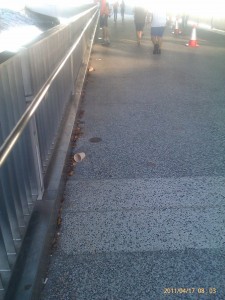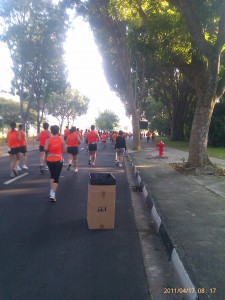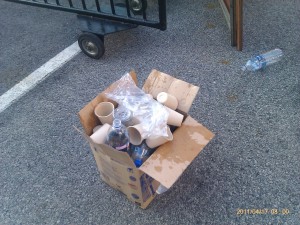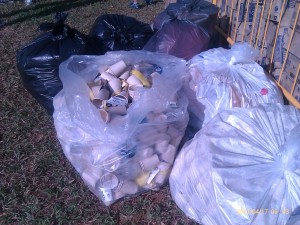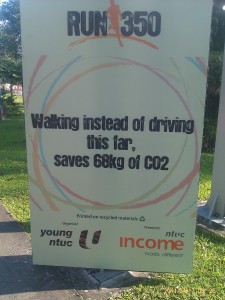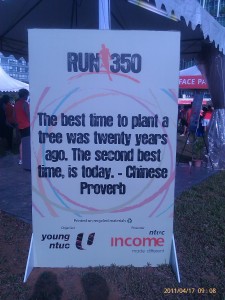April 18th, 2011
On 17 Apr 2011, my hubby and I pulled ourselves out of bed much earlier than usual and headed toward town (Marina Boulevard area) to take part in “Run 350”. Other than wanting to lend our support for this “one-and-only-10km-eco-run-in-Singapore”, we also wanted to see for ourselves the eco efforts that were currently taking place in Singapore.
For background, the run was named as such to remind everyone of the need to keep carbon emissions in the atmosphere to 350 parts per million (ppm). This effort is crucial if we are to ensure mankind’s long term survival on this planet. Currently, the level of carbon dioxide in the atmosphere is about 390ppm, and the excessive green house gas is contributing to serious problems like global warming and climate change. Hence, the run seeks to create environmental awareness on how all of us could reduce our carbon emissions and lead more eco-friendly lives, in a fun way.
It only makes sense for a run with the message of environmental protection to leave as little environmental footprints as possible in its planning and implementation. So as race participants, we took the chance to look out for the green (and not-so-green) practices that the organizers and participants engaged in for the event.
Here’s what we observed during 2011′s Run 350.
Registration and race pack collection
Registration was done online, like many of the runs that are taking place in Singapore. This practice helped save paper. Thumbs up for the good practice.
However, during the collection of the race pack, as with most runs here, participants were required to print their confirmation slips (that uses paper) and present them at the collection booth. My hubby and I have always wondered why we could not do away with the printing of the confirmation slips. The counters at the collection booths were usually equipped with laptops containing participants’ electronic records (which we provided when we registered online) and counter staff could readily retrieve our records using our identification card numbers. Doing away with the hardcopy confirmation slips could help save quite a lot of paper, especially if there’s more than 6,000 participants for the event!
[ad#article-top]
We thought Run 350 would do things differently, and so we went for our race pack collection without our confirmation slips – deliberately. But knowing that some reference information would be required, we brought along details like our confirmation numbers and other details.
At the collection booths, participants who did not bring their confirmation slips were asked to fill up separate forms. Oh no, more paper wasted! Fortunately, there was a mitigating factor. I noticed that the forms had some unrelated writings printed on the other side. This meant that the forms were possibly printed on unwanted paper (I’m giving it benefit of the doubt).
Anyway, we were given our race packs, providing just our full names, identification numbers and acknowledging our receipt of the packs. At no point was the confirmation slip critically necessary. You get my point.
One other thing we noticed was about the race pack – there were little frills in it. There were no thick stack of flyers advertising about this sports brand or that supplement product. Such flyers are usually thrown away by participants once the race packs are opened. We were glad to find only a few brochures – one on the race details, three by the event sponsor and a spa voucher. And as the organizers claimed, items in the race packs were generally useful (i.e. t-shirt, shoe bag and water bottle belt). This meant that the items would more likely be used, rather than simply contribute to more waste.
Day of Run 350 – 17 Apr 2011
Now, more about the day of the run.
In general, Run 350 was not very different from several of the other runs we had been to. Participants deposited their bags at the designated booths and headed for the starting line in anticipation of the start of the race.
But we made a few observations that we felt rather encouraged by.
At the water points, water was served to participants using paper cups made of recycled paper. In case you don’t know, it is just as important to use recycled products as it is to recycle. The “Recycling Loop” will only be completed when the new products are put to use. Good job, Run 350 organizers!
The participants also made efforts to dispose of their used cups in bins provided.
This was not the case for the other major races I had been to previously. At those runs, participants simply dumped their used cups by the side of the race track, making a mess of the race route. Either the participants for Run 350 were more environmentally conscious and hence made an effort not to litter, or the smaller participant pool of Run 350 (as compared to the major runs in Singapore) made it easier for crowd and rubbish control. I would like to think that the former reason is the correct one. While there was occasional litter here and there, they are quite minimal and the race route and event tentage areas were generally clean. Good job, Run 350 participants!
In addition, according to the official website for Run 350 in 2011, efforts were made by the organizing team in the planning of routes for logistical transportation so as to reduce unnecessary trips and as much fuel as possible. Biodiesel was also used to fuel the power generator for the event, instead of regular diesel. These are encouraging efforts that should be adopted by as many event planners as possible.
However, we also observed some things that made us rather concerned.
One thing was the medals given out to ALL participants for completing the run. Run 350 is not the only running event that gives out such medals for race completion. I do wonder whether these medals are necessary. How many of us participants actually have any use for our completion medals? Granted, some runs are very memorable and so we might want to keep a souvenir. But I believe for many of the participants, the medal actually ends up sitting at one corner of our cupboards, and eventually in the rubbish bin destined for the incinerator. What a waste of metal and resources. Maybe more environmentally friendly and useful souvenirs could be explored in future.
Besides the medals, we also observed that many plastic bottles were left from the event as a result of the drinking stations. The organizers attempted to mitigate the situation by dispensing water from larger 1.5-litre bottles instead of smaller 300ml or 500ml bottles, which helped reduce the number of waste plastic bottles created. However, the number of waste 1.5-litre bottles generated was still substantial.
One question we had was what would happen to all the waste bottles. Given the nature of the event, recycling seemed like a natural way to handle the waste plastic. However, we were not that sure whether the bottles would actually be sent for recycling, because we observed that many of the waste bottles were thrown together with other trash like used paper cups and banana skin.
I hate to imagine these plastic bottles being sent to the incinerators when they could actually be recycled. Yet if the organizers had intended to sort out the trash at the end of the event and send all the waste bottles for recycling, I wondered why they hadn’t taken the chance to educate the participants about the good practices when recycling – i.e. sorting out the recyclables by type to reduce contamination and facilitate recycling. This point leads me to the next issue.
Along the race track and event tents, there were some attempts here and there to educate participants on green practices they could adopt, such as through banners and posters. And there were also information online for creating environmental awareness.
However, I do wonder how much environmental awareness had been achieved through the event. How many of the participants actually became more environmentally conscious after the event? Or was it simply just another run event for them? Were all the effort and resources used for the event really worth it?
I do not think I became more environmentally conscious after the event, or learnt very much more, except that in Singapore, each person produces about 1,230 kg of waste annually. The theme for the run could definitely be put across stronger. More efforts at public education should accompany the event as well.
Overall, Run 350 does make an effort to go green. However, there is definitely a lot more room for improvement if the organizers wish to achieve the goals they have set for themselves – create public awareness of environmental issues.
[ad#article-top]
